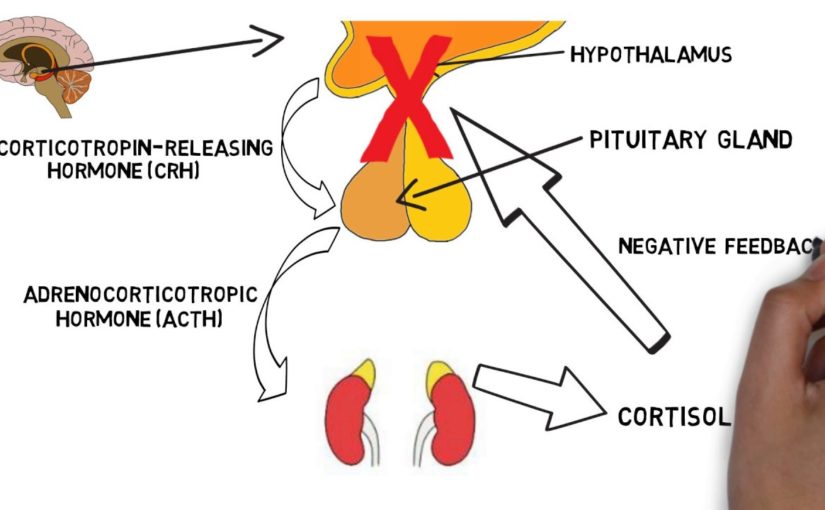
[♩ INTRO ] Stress happens. And that’s not always bad—starting a new
job or getting married can both be happy things, but they also can be really stressful. There are some kinds of stress that just don’t
seem to go away, though. Like the feeling that you’re drowning in
work, but still perpetually worried about making ends meet. If you deal with a lot of stress every day,
for months or years on end, then stress doesn’t just feel awful—it actually causes you physical
harm. Psychologists call any event or situation
that puts pressure on you or threatens your well-being a stressor, while stress refers
to your psychological and physical reactions. Stressors that are one and done—like locking
your keys in your car, or forgetting your wallet—bring on acute stress. But when stressors are repeated or continuous,
that’s chronic stress.
Things like abusive relationships, living
in poverty, and being discriminated against have all been shown to cause chronic stress. And that psychological anguish takes a toll
physically. When you experience acute stress, your body
activates a system called the hypothalamic-pituitary-adrenocortical axis, or just HPA axis because why would you
want to say all that other stuff over and over again. It starts deep in your brain, in the limbic
system — the part responsible for a lot of your automatic emotional reactions, among
other things. There, a region called the hypothalamus releases
hormones that start a whole chain of more hormones being released — first by your
pituitary gland, and then by your adrenal glands, which release a bunch of adrenaline
and cortisol into your bloodstream. And those two hormones trigger the “fight-or-flight”
response. They boost physical activity by increasing
your blood sugar and the blood flow to your muscles, and bump up your metabolism at the
same time.
The idea is that the physical boost helps
you fight the stressor or run away. So, like, if you were suddenly face to face
with a bear, the surge in energy would help you either outrun it, or go all like Revenant
on it. The same system is activated by chronic stress,
but things get a bit more complicated. Researchers have found that people under some
kinds of chronic stress have perpetually high cortisol levels, as if their HPA axis is running
constantly. For others, it can depend on the timing, with
higher cortisol levels near the start of the stress before it actually dips lower than
usual.
But we do know that while this stress reaction
can be helpful at times, having it running all the time is a problem. People under chronic stress are at higher
risk for all kinds of ailments, like heart disease, autoimmune diseases, and mental disorders
like anxiety and depression. That’s because, in addition to it being
super unpleasant to be stressed out all the time, the stress response is constantly sapping
your energy. The resources used by fight-or-flight have
to come from somewhere, and one of the places they come from is your immune system.
On the molecular level, the same cortisol
that works to get extra glucose to your muscles also stops your body from making as many infection-fighting
white blood cells as it normally would. So stress can tank your ability to fight infections. It's kind of like evolution is telling your
body not to worry about fighting off that cold right now, because you need to fight
that bear that is right in front of you. Except with chronic stress, the bear isn’t
a bear. It’s your crappy job. Or your unhappy relationship. Or whatever it is that stresses you out all
the time. And that means your immune system never gets
the chance to recover and deal with that cold as easily as it normally would. One famous experiment demonstrating this involved
11 dental students who volunteered to have their mouths biopsied twice: first during
summer vacation, and then again during exam week.
It took an average of 3 days longer for the
wounds to heal while they were stressed about exams. All kinds of other studies have gotten similar
results — some by punching small holes in people like they did with the dental students,
and others by observing how stress affects recovery from surgery and other major wounds. There's also research suggesting that chronic
stress explains part of the relationship between poverty and health.
Even just the perception of being in a lower
socioeconomic class is associated with an increase in respiratory infections. Stress can also advance the aging process. By the time you get older, your DNA has had
to replicate so many times that the protective parts at each of the ends of the chromosome,
called telomeres, can kind of start to fray. When telomeres are shorter, it's more likely
that there will be errors in copying genes. And those errors increase your risk of disease. There’s evidence that having more cortisol
in your blood interrupts the repair of telomeres. Which might explain why stress is linked to
diseases that are also associated with age, like heart disease, cancer, and anemia.
To stay healthy, the best thing you can do
is get rid of the chronic stress. But, easier said than done. If you can’t get rid of it completely, things
like meditation and relaxation therapies can help lower your stress response. And, weirdly enough, so might changing how
you think about stress. Studies have shown that when people think
about the source of stress as a challenge to overcome instead of a threat to their well-being,
that seems to lower their perceived stress and reduce their body’s physical response. There’s another way you might be able to
improve your health, too: help others reduce their stress. In a sample of over 800 older adults, those
with high stress who also reported helping friends or neighbors with things like housework
or childcare had mortality rates similar to those with low stress. Whereas those with high stress who didn’t
help out had reduced odds of survival. So, chronic stress is not good for anyone. But even if you can’t avoid being stressed
out all the time, there are ways to help yourself relax — and sometimes you can even reduce
other people’s stress in the process.
Thanks for watching this episode of SciShow
Psych! If you want to keep up to date with our latest
videos explaining how these big ole noggins of ours work, head over to youtube.com/scishowpsych
and click on that subscribe button because it’ll all come into your subscription box
and you’ll watch every single one of them and it really helps… with the YouTube algorithm. Thank you! [♩ OUTRO ].

Welcome to Neuroscience for two minutes, where I excuse neuroscience topics in two minutes or Less In this batch, I will explain the HPA axis Both the hypothalamus the pituitary gland the adrenal gland, is known for its axis in its interaction with stress. The HPA axis includes a group of hormonesecreting glands from the nervous and endocrine organizations Under the hypothalamus, pituitary gland and adrenal glands The hypothalamus is the small neural endocrine arrangement set above the ability stanch Authorities the secretion of hormones from the pituitary gland, a hormonal gland Lies merely below the mulch The pituitary can secrete hormones in the bloodstream to reach a variety of purposes In the case of vehicles of the HPA axis, hormones liberated from the pituitary gland are transmitted To the kidneys and alter hormone secretion from the endocrine glands called the adrenal glands Which is located above the kidneys The primary capacity of the HPA axis is to regulate the stress response When we suffer from a traumatic thing, the hypothalamus liberates a hormone called the freeing hormone Corticotropin or( CRH) CRH refers to the pituitary gland to exude a hormone called adrenocorticotropic hormone Or ACTH in the bloodstream ACTH hastens to the adrenal glands where it expects the secrete of a hormone called Cortisol from the adrenal cortex, or outer blanket, from the adrenal glands The secrete of cortisol campaigns a number of changes that help the body cope with stress For lesson: Assists build up energy like glucose, so the body has enough vigor to cope Long press When cortisol degrees rise in the blood This is felt by receptors in the brain regions such as the hypothalamus and the hippocampus, which stops the stress response Through what is known as the mechanism of negative actions Do the rendition: Shwan Hamid Twitter:@ shwanBBBBBhamid

As found on YouTubeNew Explaindio 4 is revolutionary technology which creates fascinating videos by combining 2D & 3D animations, whiteboard sketch elements, and full motion video, all into one powerful, attention grabbing video. This is why I am extremely excited to be able to tell you that now there is Explaindio 4, which is an easy to use video content creation software that allows you to combine 2D & 3D animations, whiteboard sketch elements, and full motion video, all into one powerful, attention grabbing video.
We all know how stressful exam time can be. When we let our stress levels get too intense for long periods of time, it can have negative effects on our physical and mental well-being. But stress itself isn’t all bad. If we understand the science of what’s happening in our bodies when we feel stressed, we can learn to keep those feelings balanced and make them work for us. So how do we do that? Watch this video for scientific tips on how to tame your stress and let it do its job – preparing you for the challenge ahead!Credits:
Produced by Orinoco Communications
Animation: Rosie Holtom
Illustration: Alex Scarfe
Narration: Ellie Lees
Focus group: Olga Markoulides and her students at Newham Sixth Form College
Scientific advisors: Sarah Hall, Hans Reul, Francesca Spiga, Phil Rhodes
Director: Peter Barker
We can’t avoid having stress, and that’s not always a bad thing. But if you are dealing with a lot of stress every day, it might cause you physical harm.Hosted by: Hank Green
———-
Support SciShow by becoming a patron on Patreon: https://www.patreon.com/scishow
———-
Dooblydoo thanks go to the following Patreon supporters:
Kelly Landrum Jones, Sam Lutfi, Kevin Knupp, Nicholas Smith, Inerri, D.A. Noe, alexander wadsworth, سلطان الخليفي, Piya Shedden, KatieMarie Magnone, Scott Satovsky Jr, Bella Nash, Charles Southerland, Bader AlGhamdi, James Harshaw, Patrick Merrithew, Patrick D. Ashmore, Candy, Tim Curwick, charles george, Saul, Mark Terrio-Cameron, Viraansh Bhanushali, Kevin Bealer, Philippe von Bergen, Chris Peters, Justin Lentz
———-
Looking for SciShow elsewhere on the internet?
Facebook: http://www.facebook.com/scishow
Twitter: http://www.twitter.com/scishow
Tumblr: http://scishow.tumblr.com
Instagram: http://instagram.com/thescishow
———-
Sourceshttp://www.apa.org/helpcenter/understanding-chronic-stress.aspx
http://sites.google.com/site/sarahpressman2/millerchenzhou2007.pdf
https://www.ncbi.nlm.nih.gov/pubmed/15574496
http://www.nature.com/nature/journal/v490/n7419/full/490169a.html
https://www.ncbi.nlm.nih.gov/pmc/articles/PMC3401586/
https://www.ncbi.nlm.nih.gov/pubmed/18279846
https://www.ncbi.nlm.nih.gov/pubmed/9625226
https://www.ncbi.nlm.nih.gov/pubmed/1674771
http://www.sciencedirect.com/science/article/pii/014067369193068K
https://www.ncbi.nlm.nih.gov/pubmed/10681901
https://www.ncbi.nlm.nih.gov/pubmed/17201569
http://library.allanschore.com/docs/MaltreatmentHPAGunnar06.pdf
https://www.ncbi.nlm.nih.gov/pmc/articles/PMC2853611/
https://www.ncbi.nlm.nih.gov/pmc/articles/PMC4464969/
http://psycnet.apa.org/record/1993-44556-001
https://www.ncbi.nlm.nih.gov/pubmed/20604855
https://www.ncbi.nlm.nih.gov/pmc/articles/PMC3780662/
https://www.ncbi.nlm.nih.gov/pmc/articles/PMC3374921/
https://www.ncbi.nlm.nih.gov/pmc/articles/PMC3052954/
https://www.ncbi.nlm.nih.gov/pubmed/18190880Image Sources:
https://commons.wikimedia.org/wiki/Category:Cortisol#/media/File:Cortisol-2D-skeletal.png
https://commons.wikimedia.org/wiki/Epinephrine#/media/File:Epinephrine.png


